Hubei Ruiyuan Electronic Co.,Ltd.
Electrohydrodynamic Printing of Self-Stacked Fiber-Based Detectors: A New Strategy for Highly Sensitive, Low-Power Consumption via Piezo-Phototronic Coupling
Release time:
2025-08-22
Amid rapid advances in flexible electronics and communication technology, compact and lightweight photodetectors have become a core requirement for 6G and integrated chip technologies, with flexible devices demonstrating strong application potential.However, conventional flexible photodetectors face bottlenecks such as weak interfacial adhesion and high power consumption. Achieving effective integration of flexible substrates with photosensitive materials for both high sensitivity and low power consumption is a key global research focus.
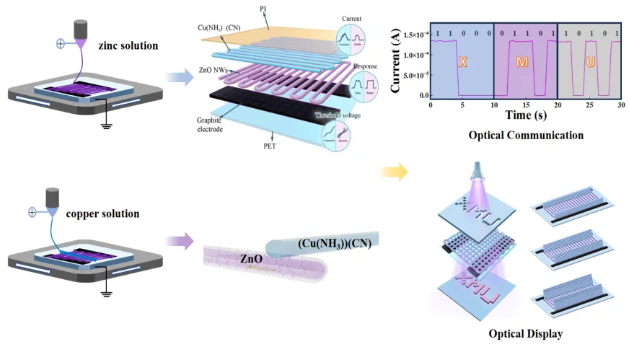
Recently, Professor Gaofeng Zheng's team at Xiamen University published research in Advanced Fiber Materials titled 'Piezophototronic Effect-Enhanced Highly Sensitive Flexible Photodetectors Based on Electrohydrodynamic Direct-writing Nanofiber Self-stacking'.This work proposes a micro/nano piezo-phototronic coupling enhancement mechanism. Utilizing electrohydrodynamic direct-writing self-stacking, the team fabricated ZnO@(Cu(NH3)4)(CN) flexible detectors. By synergistically regulating nanoscale charge transport and enhancing interfaces through multi-layer stacking, the devices achieve high sensitivity and low power consumption, opening new technological pathways for short-range communication, encryption, and display applications.
This work reveals a micro/nano-scale piezo-phototronic coupling enhancement mechanism and develops an electrohydrodynamic direct-writing self-stacking printing technology. It successfully integrates copper-ammonia complex (Cu(NH₃)₄)(CN) nanofibers with zinc oxide (ZnO) nanofibers, fabricating high-performance ZnO@(Cu(NH₃)₄)(CN) flexible photodetectors deployed in UV encryption communication and display systems (Fig. 1).
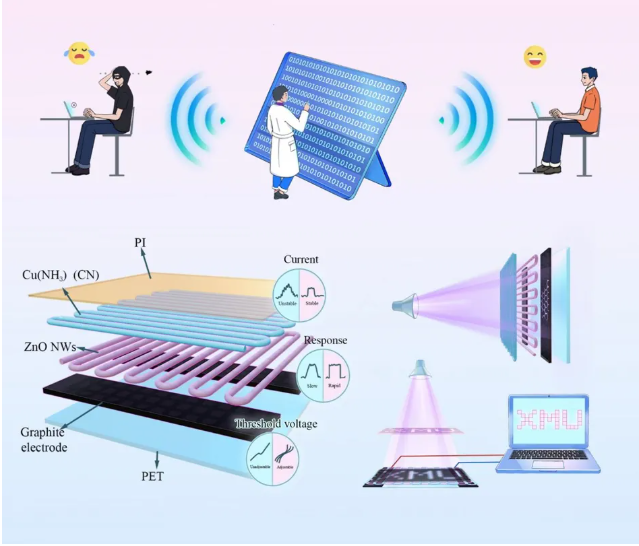
Fig. 1 Structure, principle, and applications of the self-stacked photodetector
Electrohydrodynamic direct-writing enabled self-stacking of piezo-phototronic materials, with thermal curing constructing dense interfaces for device integration, as shown in Fig. 2(a). Fig. 2(b)-(e) Characterization of the ZnO@(Cu(NH₃)₄)(CN) flexible piezo-enhanced photodetector, showing a 230 nm absorption peak and high sensitivity to UV spectrum.
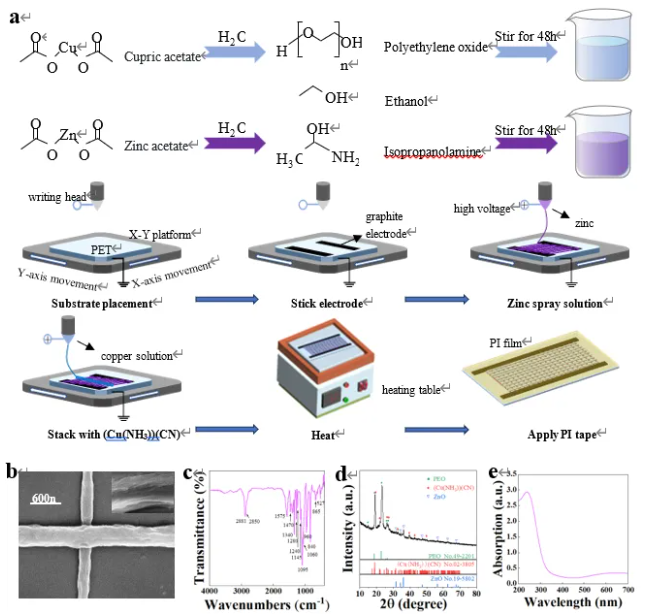
Fig. 2 Fabrication process and optoelectronic characterization of the photodetector
The ZnO@(Cu(NH₃)₄)(CN) photodetector achieves ultralow power consumption and fast response: self-stacked nanofibers create discontinuous energy band barriers that suppress hot electron emission, reducing dark current to 1.12×10⁻⁷ A (nearly 3 orders lower than pure ZnO nanofibers) and sharply decreasing static power consumption. Under UV irradiation, responsivity reaches 13.3 A/W with rise/recovery times of only 11 ms/9 ms, significantly outperforming conventional flexible detectors (Fig. 3).It features a wide tuning voltage range (6-20 V), enabling compatibility with diverse application scenarios.
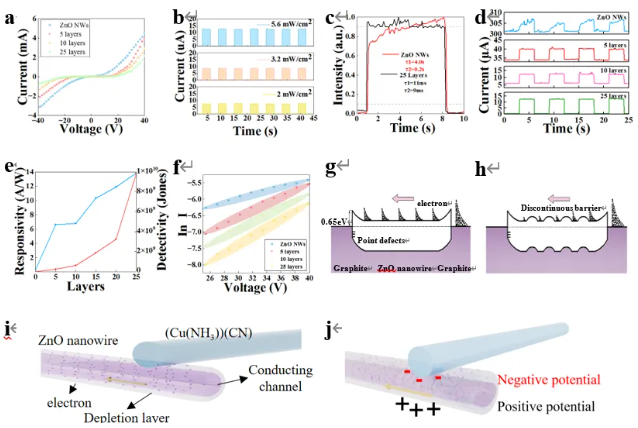
Fig. 3 Performance and piezoelectric effect of the flexible photodetector
Based on the ZnO@(Cu(NH₃)₄)(CN) photodetector, the team constructed an integrated UV communication-display system featuring low power consumption, tunable thresholds, and electromagnetic shielding resistance (Fig. 4).The system leverages UV light's low-noise and weak penetration properties, combined with physical-layer mask encryption (transceiver-shared key template), to achieve secure short-distance transmission of "XMU" characters with rapid response and strong anti-interference capabilities, providing a new paradigm for near-field secure communication.
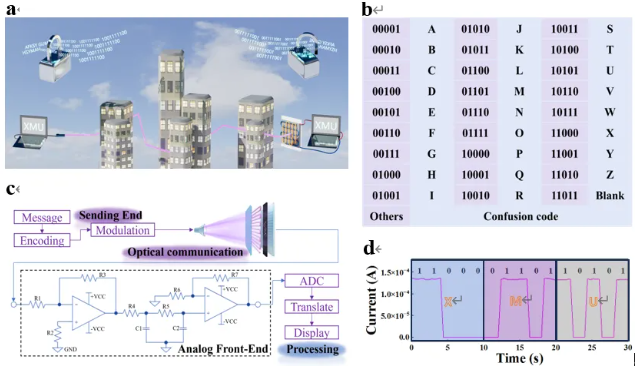
Fig. 4 Photodetector application in communication systems
Fig. 5 demonstrates the application of ZnO@(Cu(NH₃)₄)(CN) photodetectors in UV display. The system employs a mask template protocol to modulate optical signals through movable masks. The detector collects current data, which is processed and color-mapped by computer based on sensitivity, ultimately generating clear images.The experiment demonstrates the display of letters "X," "M," and "U" using detectors with varying stacking layers. This application highlights the detector's potential in information visualization and offers a novel approach for display technology development.

Fig. 5 Photodetector implementation in UV display systems
In summary, this study successfully fabricated ZnO@(Cu(NH₃)₄)(CN) flexible piezo-enhanced photodetectors via electrohydrodynamic direct-writing self-stacking technology. By introducing a piezo-phototronic synergistic coupling mechanism, it addresses critical challenges in interfacial regulation and power consumption reduction for flexible photodetectors, providing robust technical support for 6G communications, battlefield encryption, and smart wearable devices.Future research will focus on seamless integration of the detectors and optimizing the balance between optoelectronic performance and mechanical robustness, which will significantly advance next-generation flexible photodetection technology.
Xianruo Du (PhD candidate, Xiamen University), Zhenghui Peng (Undergraduate, Ocean University of China), and Yanyang Liang (Undergraduate, Xiamen University) are co-first authors. Prof. Gaofeng Zheng (Xiamen University) and Asst. Prof. Huatan Chen (Xiamen University of Technology) are corresponding authors.
Corresponding Author Biography
Gaofeng Zheng: Professor and PhD supervisor, Director of the Scientific Instrument Institute at the Xiamen University Samning Micro-Nano Science and Technology Research Institute. His research focuses on electrospinning, smart fiber manufacturing, and flexible electronics integration. He is a recipient of the Fujian Provincial Outstanding Youth Fund, Fujian High-Level Talent, Fujian "Eaglet Plan" Young Top Talent, and Xiamen "Double Hundred Plan" Leadership Entrepreneurial Talent. He has received one Second Prize of Fujian Provincial Science and Technology Progress Award, one Second Prize of Xiamen Science and Technology Progress Award, and one First Prize of the China Invention Association Invention Entrepreneurship Innovation Award. He has presided over sub-projects of the National Key R&D Program, National Natural Science Foundation projects, Fujian Province Industry-University-Research Key Projects, and Fujian Provincial Natural Science Foundation projects. He has published over 160 papers, authorized more than 50 invention patents, published one monograph, and contributed three book chapters.
Citation: China Electronic Components Association.
Retrieved from http://www.ic-ceca.org.cn
Online Message

